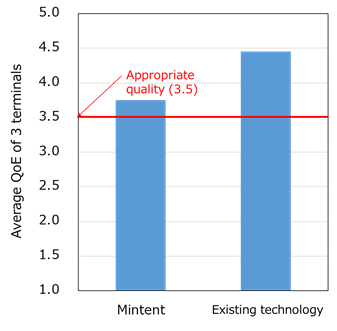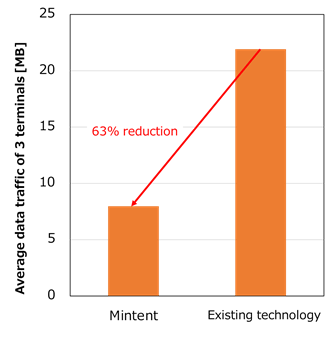Microsoft ends support for Internet Explorer on June 16, 2022.
We recommend using one of the browsers listed below.
- Microsoft Edge(Latest version)
- Mozilla Firefox(Latest version)
- Google Chrome(Latest version)
- Apple Safari(Latest version)
Please contact your browser provider for download and installation instructions.
August 30, 2022
NTT Corporation
NTT COMWARE CORPORATION
Web Conferencing without Interruptions by Controlling Data Traffic
--Technology for Optimizing Quality of Experience and Data Traffic (Mintent)--
NTT Corporation (Head Office: Chiyoda-ku, Tokyo; Akira Shimada, President & CEO; "NTT") has established quality-of-experience (QoE) and data-traffic optimization technology (referred to below as Mintent®) by focusing on the fact that the requirements (intent) that service users and service providers have for services differ for each service.
NTT and NTT COMWARE CORPORATION (Head Office: Minato-ku, Tokyo; President: Masato Kuroiwa; "NTT COMWARE") have incorporated Mintent in web conferencing services and have confirmed through a joint experiment that data traffic could be reduced by as much as 63% while maintaining QoE in the video and audio received during a web conference.
Based on the results of this joint experiment, NTT COMWARE incorporated Mintent in its document-sharing service letaria® and began commercial provision in August 3, 2022 as the first commercial service using Mintent.
1. Background
Noticing that the requirements (intent) that service users and service providers have for services have so far differed for each service, NTT came to research and develop Mintent*1 (Intent AI Mediator).
For example, the user of a web conferencing service has the requirement of wanting to use the service without any interruptions while the provider of a video delivery service has the requirement of wanting to lengthen the viewing time of the service user. The provider of a connected car service, meanwhile, has the requirement of wanting to detect an anomaly based on conditions inside and outside the car.
In this way, it is important that services be provided based on requirements that differ for each user. However, to meet these requirements, it would be necessary to prepare an unlimited amount of resources for the network, cloud server, and application, which means that providing such services could lead to social issues such as an increase in power consumption that could simply be inappropriate from an environmental perspective.
With the above in mind, the need is felt for establishing technology that can convert the requirements of service users and providers into numerical information that can be interpreted by the network, cloud server, and application and for establishing technology that can control ICT resources based on that information.
Amid studies toward developing these technologies, the COVID-19 pandemic of recent years has driven the widespread use of remote working throughout the world and has increased the demand for web conferencing services. Conventional web conferencing services, however, transmit video with excessive data traffic to enhance video quality when the service user's terminal is connected, for example, to a high-speed network with high throughput. On the other hand, if connected to existing networks, throughput can vary widely due to network congestion or other factors, and this can result in interruptions to web conferencing since sudden transmissions of a small amount of data that result in low video quality cannot be dealt with.
To therefore achieve web conferencing that makes interruptions difficult to occur as demanded by users of web conferencing services, NTT established QoE and data-traffic optimization technology (Mintent) to control the amount of data communications used by the service user based on QoE when participating in web conferencing. This is one technology of the Mintent technology group (Intent AI Mediator). Mintent uses video information such as bit rates obtained from the web conferencing server to calculate the amount of data to be transmitted so that QoE of each service user several tens of seconds into the future satisfies an appropriate level of quality. It then instructs each user terminal the amount of transmission data that can maintain that appropriate level of quality (Figure 1). In this way, Mintent reduces data traffic while maintaining an appropriate level of quality thereby achieving web conferencing robust to interruptions.
 Figure 1 QoE and data traffic optimization technology (Mintent)
Figure 1 QoE and data traffic optimization technology (Mintent)
2. Joint Experiment and Results
To satisfy the requirement of service users for "web conferencing robust to interruptions," NTT and NTT COMWARE began a joint experiment in March 2021 using QoE and data-traffic optimization technology (Mintent) to determine whether controlling communications to prevent an excessive amount of data traffic could solve past problems. The roles of NTT and NTT COMWARE in these experiments were divided as follows.
- NTT: Provides Mintent as a technology for reducing data traffic while predicting QoE of the service user and approaching an appropriate level of quality
- NTT COMWARE: Incorporates Mintent in its document-sharing web conferencing service letaria and provides an experimental environment
 Figure 2 Comparison of QoE between Mintent and existing technology
Figure 2 Comparison of QoE between Mintent and existing technology
 Figure 3 Comparison of data traffic between Mintent and existing technology
Figure 3 Comparison of data traffic between Mintent and existing technology
Web conferencing was performed with two personal computers and one smartphone using letaria equipped with Mintent while measuring QoE and data traffic. Figure 2 shows the average value of QoE (based on a 5-level quality scale: excellent, good, fair, poor, and bad) for these three terminals and Figure 3 shows the average value of data traffic for the same terminals. Here, in evaluating by this 5-level quality scale, it is known that a QoE of 3.5 means that more than 90% of service users evaluated the service as "fair or better", which is why results are shown with this value indicated as "appropriate quality."
With existing technology, the results obtained show a level of QoE exceeding appropriate quality combined with high data traffic when the service user's terminal is connected to a high-speed network. With Mintent, on the other hand, it was confirmed that data traffic could be reduced by as much as 63% compared with existing technology while the user is experiencing the service with appropriate quality (Figure 3). In short, incorporating Mintent in letaria enables a web conferencing service robust to interruptions to be used with an appropriate level of quality without an excessive amount of data traffic even during congestion on a high-throughput network.
3. Future Plans
It is expected that QoE and data-traffic optimization technology (Mintent) will also play a role in reducing terminal power consumption by virtue of its ability to reduce data traffic, so NTT plans to confirm whether this is actually the case. Additionally, in FY2022, as a successor technology to Mintent (Intent AI Mediator), NTT COMWARE plans to also incorporate Mintent as server resource optimization technology, which is a cloud server control technology already established by NTT, in letaria. The aim here is to achieve system stability and scalability with an optimal amount of resources.
NTT will work to establish control technology targeting video delivery based on the requirement of lengthening the viewing time of the service user and control technology targeting connected cars based on the requirement of appropriately detecting any anomalies based on conditions inside and outside the car.
*"Mintent" is a registered trademark of NTT Corporation.
*"letaria" is a registered trademark of NTT Comware Corporation.
<Terminology>
*1Mintent: A coined word combining the 'M' in "mediation" with the word "intent." Mintent calculates the amount of ICT resources for satisfying the requirements of service users and providers and performs cooperative control of the network, cloud server, and application based on that amount of resources. Mintent can also be used as independent technologies—network control technology, cloud server technology, and application control technology—based on the requirements that service users and service providers have for services. Specifically, in this document, Mintent (Intent AI Mediator) refers to a technology group independent of services, Mintent (QoE and data-traffic optimization technology) refers to application control technology, and Mintent (server resource optimization technology) refers to cloud server control technology.
Media Contact
Planning Department, Public Relations Section
NTT Information Network Laboratory Group
nttrd-pr@ml.ntt.com
Public Relations Section
NTT Comware Corporation
kouhou@nttcom.co.jp
Information is current as of the date of issue of the individual press release.
Please be advised that information may be outdated after that point.
NTT STORY
WEB media that thinks about the future with NTT










